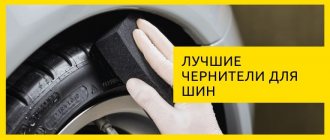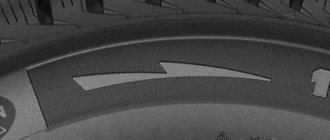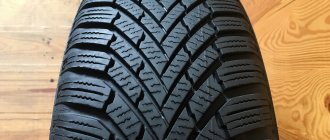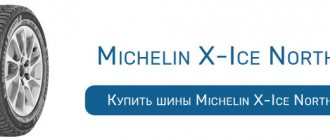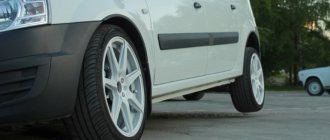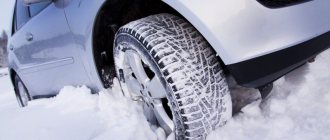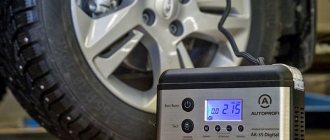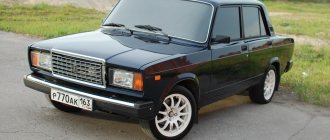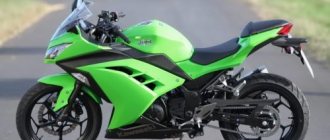Rivals
Up to 4000 rub.
per tire The category of the cheapest models - up to 4,000 rubles per tire - is represented by the domestic Viatti Bosco Nordico
in company with the Chinese
Sailun Ice Blazer WST 3
and
DoubleStar WinterKing DW07
.
The other trinity is a little more expensive - a pair of “Russians”, our popular Formula Ice
(“the youngest” from the Pirelli family) and the new
Cordiant SnowCross 2 SUV
, as well as the Chinese
Triangle Icelink Sport Utility
.
Table: Top 12 best tires
| Model | Best Features | Diameter, R | Run Flat | Maximum speed index | |
| Pirelli Ice Zero | studded according to reviews | 14/15/16/ 17/18/19/ 20/21/22 | optional | H (up to 210 km/h) | Find out prices |
| Bridgestone Blizzak Revo GZ | studless tires according to reviews | 13/14/15/ 16/17/18/ 19 | No | S (up to 180 km/h) | Find out prices |
| Continental IceContact 2 | studded 2021 – 2017 | 13/14/15/ 16/17/18/ 19/20/21 | optional | T (up to 190 km/h) | Find out prices |
| Continental ContiWinterContact TS850 | studless 2021 – 2017 | 12/14/15/ 16/17/18/ 19/20/21 | optional | W (up to 270 km/h) | Find out prices |
| Continental IceContact 2 SUV | studded for crossovers | 15/16/17/ 18/19/20/ 21 | optional | T (up to 190 km/h) | Find out prices |
| Bridgestone Blizzak DM-V2 | studless for crossovers | 15/16/17/ 18/19/20/ 21/22 | No | T (up to 190 km/h) | Find out prices |
| Nokian Tires Hakkapeliitta 5 | inexpensive | 13/14/15/ 16/17/18/ 19/20 | optional | T (up to 190 km/h) | Find out prices |
| Cordiant Winter Drive | budget (Velcro) | 13/14/15/ 16/17 | No | H (up to 210 km/h) | Find out prices |
| Nokian Tires Hakkapeliitta 8 | studded, “Behind the wheel” test | 13/14/15/ 16/17/18/ 19/20/21 | optional | V (up to 240 km/h) | Find out prices |
| Nokian Hakkapeliitta R2 | studless, “Behind the wheel” test | 15/16/17/ 18/19/20/ 21 | optional | R (up to 170 km/h) | Find out prices |
| Nokian Tires Hakkapeliitta 9 | studded, “Autoreview” test | 16/17/18/ 19/20/21/ 22 | optional | T (up to 190 km/h) | Find out prices |
| Nokian Tires Hakkapeliitta R2 SUV | studless, review “Autoreview” | 14/15/16/ 17/18/19/ 20/21 | optional | R (up to 170 km/h) | Find out prices |
...and in the snow
A long snow plateau allows you to make five or six combined measurements (acceleration and deceleration) in one direction. Here we slightly raise the upper bar, increasing the speed “ceiling” to 40 km/h. Acceleration from a standstill, that is, from zero, and the braking distance is cut off at the same 5 km/h.
Here the results are more consistent than on the ice. In braking, ten (!) participants show similar results, the difference between them is only 20 cm. The best is Continental, the worst is DoubleStar.
When accelerating, second-line brands unexpectedly take the lead. Gislaved and Nordman are shown for the first time. The first tire has an asymmetrical tread, while the second has a directional tread. But both cling to the snow during acceleration better than others. The last result is again for the DoubleStar tire.
Big test of winter tires 225/50 17 2021
Every time, when planning winter tire tests, Autoreview experts play temperature roulette: will it be frost or thaw, snowfall or rain?..
This year, at the end of February, real spring happened in Swedish Arvidsjaur: at the end of the tests +6°C! Fortunately, at the beginning of the test week there were frosts in the twenties, which made it possible to build a temperature gradient for thirteen models of winter tires.
This is just one of the areas of the test site - a controllability track and a track for measuring longitudinal dynamics. But the ice tracks are located near the airport, and such shots cannot be taken there: the area is closed to copters.
There are only three new items among the test participants: Continental IceContact 3 studded tires and two friction models of Japanese origin: Bridgestone Blizzak Ice and Toyo Observe GSi-6. The rest of the “hot cakes” were not ready for the start of our tests, and don’t even ask about Michelin X-Ice North 4: literally a week before the start of the test, the French company refused to participate. It's a pity.
“Test track, access only to authorized personnel. Life threatening!"
The remaining ten models are familiar to readers from last year's tests. But firstly, technology changes every year. And secondly, the pilots repeated the program of measuring longitudinal dynamics three times - at three different temperatures. And the controllability was tested first on dry ice at –10°C, and then the races were repeated almost on puddles already at +6°C.
To measure longitudinal dynamics, a Volkswagen Golf is used, equipped with professional equipment with a high-precision GPS receiver.
More than ten accelerations and decelerations are performed on each set of tires - and each measurement is performed on a fresh patch of ice.
Of the six studs in the current company, four have an increased number of “nails” - in each tire there are much more of them than the 60 studs per linear meter required by regulations. But just like in the Scandinavian countries (where the norm is 50 studs per linear meter), we can sell tires with any number of studs if they have passed the overrun test, that is, they have confirmed during field tests that they do not wear out the road surface any more. True, the wear assessment is carried out on granite tiles, and not on real asphalt - and at a speed of 100 km/h. On our highways the traffic flows at 130 km/h, and in some places on toll sections it reaches 150 km/h. Taking into account the poor quality of the asphalt, rutting in the left lanes is precisely the work of studded tires.
Measurements of acceleration time on ice and compacted snow - with activated traction control.
But we cannot abandon “nails” altogether, which is what road workers dream of and as they did in most European countries. According to measurements from Autoreview experts, studs reduce the braking distance of a car on ice by an average of 30 percent! And they are especially effective at temperatures close to zero. And in cold weather, the ice becomes harder and it is more difficult for the spikes to scratch it: the mechanical grip deteriorates - and the performance of the rubber comes to the fore.
Start with slipping on ice - and you can count the stud lines: the more there are, the more efficiently the studs work.
However, not everything depends only on temperature: humidity, wind, light drifting snow can significantly affect the coefficient of adhesion. Even on perfectly prepared test tracks, ice conditions vary widely. How many types of snow do Eskimos know there - more than a hundred? So, winter tire testers will tell you about the same variety of ice: natural, artificial, lake, swamp, morning, daytime, loose, porous, polished, hardened, frosted, melted... And each has its own coefficient of adhesion.
On the icy handling track we were able to compare the tires at a temperature of +6 degrees. And the next day the ice of this lake flooded: spring had come.
After measurements at different temperatures, we can say for sure that both studded and friction tires perform worse as the temperature decreases. But the dependence on temperature is not always linear and unambiguous—it is the roughness of the ice that influences it. After all, if you look at the tread of friction tires close-up, then it is a lot of rubber edges that cling to micro-irregularities. In this test at a temperature of -10°C, the roughness of the ice turned out to be such that good friction tires were preferable: on the handling track, the best lap time was achieved by the Continental VikingContact 7 tires. And the worst was achieved by the Yokohama studs! But at a positive temperature, a layer of water had already appeared on the ice, and in these conditions the studded tires left no chance for the friction tires - on a 780-meter circle the lag was from six to fourteen seconds!
It is not surprising that, based on the sum of all the results, we recognized the new studded Continental IceContact 3 – with “rubber” studs – as the best winter tires this season. Although if you cut this one, you will find a small aluminum body under the rubber shell - an insert made of a hard alloy based on tungsten carbide rests on it.
Winter tires with their soft treads float up early on “big water” - even the best of them do not allow you to accelerate to 60 km/h, although with summer tires of the same width you can easily reach more than 70 km/h on this track.
It seems that the era of Nokian tire hegemony, which has lasted for the last seven years, is over. However, the Hakkapeliitta 9 still remains one of the best winter tires on the market. True, the two leaders are very expensive. But if you are not a perfectionist, then you can easily choose tires from the second line of the same manufacturers - Gislaved Nord*Frost 200 or Nordman 7. Hankook and Yokohama studs are also worthy of attention: their lag from the leaders is compensated by the price.
To evaluate cross-country ability, we use virgin snow 12 cm deep: on all tires the Audi accelerates normally, and only the Bridgestone Blizzak Ice tires do not plow.
In the non-studded class, the situation is similar: Continental VikingContact 7 tires are the favorites, Nokian Hakkapeliitta R3 is in second place, and Nordman and Hankook represent a reasonable combination of price and quality. Well, the three Japanese models close the ranking. And their best representative is the Yokohama iceGuard iG60 tires.
Studded tires
| Dimension | 225/50 R17 |
| (28 sizes from 175/65 R14 to 255/50 R19) | |
| Speed index T | (190 km/h) |
| Load capacity index | 98 (750 kg) |
| Weight, kg | 11,1 |
| Tread depth, mm | 8,1 |
| Rubber hardness Shore at +5°C, units | 46 |
| Number of spikes | 192 |
| Number of stud lines | 18 |
| Protrusion of spikes, mm | 1,1 |
| Manufacturer country | Germany |
| Production date, week/year | 02/2019 |
For many years, the Continental company used an asymmetrical tread pattern, but numerous tests nevertheless forced the Germans to change their “religion”: the new IceContact 3 tires have a classic herringbone pattern, but instead of needles there are glued-in studs of a complex design with a rubberized body. Excellent grip on ice, high resistance to aquaplaning - which is very important in slushy urban conditions - and an enviably low noise level with so many “nails”. True, only tires with a seat diameter of 17″ and above are equipped with “rubber” studs, and for tires with smaller diameters, traditional ones are used, with which the noise level may be higher. But even in this case, IceContact 3 tires can be safely recommended for both suburban and urban winter use.
| Dimension | 225/50 R17 |
| (75 sizes from 155/70 R13 to 275/40 R20) | |
| Speed index | T(190 km/h) |
| Load capacity index | 98 (750 kg) |
| Weight, kg | 11,7 |
| Tread depth, mm | 9,3 |
| Rubber hardness Shore at +5°C, units | 44 |
| Number of spikes | 130 |
| Number of stud lines | 10 |
| Protrusion of spikes, mm | 1,1 |
| Manufacturer country | Russia |
| Production date, week/year | 43/2018 |
The Gislaved tires of the second line of the Continental concern are still asymmetrical, they have only 130 studs, and they do not require any vulcanization. On ice, the grip properties during acceleration and braking are more modest than those of Continental tires, but on the track the handling of a car with Nord*Frost 200 tires is faster! And on snow, the asymmetrical tread - exactly the same as the first generation Continental IceContact - works perfectly. On asphalt, grip properties are average, but there is little noise when rolling.
A good option for relatively affordable and, importantly, comfortable Russian-made winter tires for the city and countryside.
| Dimension | 225/50 R17 |
| (56 sizes from 175/65 R14 to 275/35 R20) | |
| Speed index | T(190 km/h) |
| Load capacity index | 98 (750 kg) |
| Weight, kg | 11,1 |
| Tread depth, mm | 8,7 |
| Rubber hardness Shore at +5°C, units | 50 |
| Number of spikes | 196 |
| Number of stud lines | 18 |
| Protrusion of spikes, mm | 0,9 |
| Manufacturer country | Finland |
| Production date, week/year | 03/2019 |
This year, on the Nokian Hakkapeliitta 9 tires, after running in, the studs protruded only 0.9 mm, compared to the norm of 1.2 mm. However, even with such indicators, Hakkapeliitta 9 became one of the most tenacious on ice - especially on “warm” ice, covered with water. On the handling track at positive temperatures, it is Nokian tires that allow you to attack corners at good speed. And in the snow, Hakkapeliitta 9 performs well.
But the main disadvantages remain on asphalt - especially on dry, where Nokian studs have one of the longest braking distances. So this is not an option for large cities. And Hakkapeliitta 9 is noisy - and very expensive.
| Dimension | 225/50 R17 |
| (58 sizes from 155/65 R13 to 255/40 R19) | |
| Speed index | T (190 km/h) |
| Load capacity index | 98 (750 kg) |
| Weight, kg | 11,7 |
| Tread depth, mm | 9,0 |
| Rubber hardness Shore at +5°C, units | 50 |
| Number of spikes | 198 |
| Number of stud lines | 18 |
| Protrusion of spikes, mm | 0,9 |
| Manufacturer country | South Korea |
| Production date, week/year | 02/2019 |
Last season, the Hankook Winter i*Pike RS² tires made a splash on the ice, but failed the doping test. This year, Korean tires did not shine in ice disciplines: the protrusion of the studs turned out to be small, 0.9 mm versus last year’s 1.2 mm. On snow, the Winter i*Pike RS² performed well, but on asphalt the grip properties leave much to be desired. But these tires resist aquaplaning well - and they make less noise than Nokian or Nordman tires. So this is a good – also in terms of price – option for “regional” winter tires.
| Dimension | 225/50 R17 |
| (34 sizes from 155/80 R13 to 235/55 R17) | |
| Speed index | T(190 km/h) |
| Load capacity index | 98 (750 kg) |
| Weight, kg | 11,8 |
| Tread depth, mm | 9,2 |
| Rubber hardness Shore at +5°C, units | 52 |
| Number of spikes | 130 |
| Number of stud lines | 16 |
| Protrusion of spikes, mm | 1,2 |
| Manufacturer country | Russia |
| Production date, week/year | 44/2018 |
Nordman 7 tires are the second line of Nokian. Fewer spikes, simpler design and materials. But in acceleration and braking on ice, the Nordman 7 even surpasses the “head” tires of the Hakkapeliitta 9! But on the handling routes, subordination is observed: there is more slipping in turns, the car does not follow the steering wheel as accurately - not only on ice, but also on snow.
The disadvantages on asphalt are the same as those of the Hakkapeliitta series tires, with the longest braking distance. And the basis of the noise spectrum is shifted towards low frequencies: more tread hum, less clattering of studs.
But the size range is more affordable: 13-inch Zhiguli tires are also available, which are still in demand in the Russian outback. There, on unclean roads, this is exactly the place for Nordman 7 tires.
| Dimension | 225/50 R17 |
| (29 sizes from 205/55 R16 to 285/60 R18) | |
| Speed index | T(190 km/h) |
| Load capacity index | 98 (750 kg) |
| Weight, kg | 11,9 |
| Tread depth, mm | 9,0 |
| Rubber hardness Shore at +5°C, units | 50 |
| Number of spikes | 172 |
| Number of stud lines | 20 |
| Protrusion of spikes, mm | 1,0 |
| Manufacturer country | Russia |
| Production date, week/year | 46/2018 |
Last year, the iG65 series tires were let down by the obscenely recessed studs. It seems that those responsible for this procedure at the Yokohama Lipetsk plant have drawn conclusions, and this year the studs on the test tires protrude by an average of 1 mm, and not by 0.7 mm, as a year earlier.
The grip properties with normal studs have improved noticeably, but, unfortunately, the bias towards acceleration remains: on these tires the Audi A4 brakes much worse than it picks up speed. In turns, constant freezing in the skid interferes. But on wet asphalt - excellent braking properties and better resistance to aquaplaning.
So Yokohama iceGuard iG65 is more suitable for urban winter use - and on those cars that have a stabilization system.
Studless tires
| Dimension | 225/50 R17 |
| (111 sizes from 155/65 R14 to 245/35 R21) | |
| Speed index | T(190 km/h) |
| Load capacity index | 98 (750 kg) |
| Weight, kg | 11,1 |
| Tread depth, mm | 8,0 |
| Rubber hardness Shore at +5°C, units | 41 |
| Manufacturer country | Germany |
| Production date, week/year | 47/2018 |
Continental VikingContact 7 tires are again the best among friction tires in all winter disciplines, and on ice they sometimes “overtake” studs! On asphalt, the level of comfort conquers, the rubber, according to our hardness measurements, is the softest here - only the special design of 3D sipes prevents the tread blocks from completely “smearing” on the asphalt during sharp braking. Such softness also threatens rapid wear during active asphalt use, and a tread without wide longitudinal grooves does not cope well with draining water from the contact patch. Moreover, most likely, this will be noticeable not only in puddles, but also in wet snow, that is, slush.
But what a beautiful trail...
| Dimension | 225/50 R17 |
| (76 sizes from 175/65 R14 to 265/35 R21) | |
| Speed index | R(170 km/h) |
| Load capacity index | 98 (750 kg) |
| Weight, kg | 10,4 |
| Tread depth, mm | 8,2 |
| Rubber hardness Shore at +5°C, units | 48 |
| Manufacturer country | Finland |
| Production date, week/year | 03/2019 |
Nokian Hakkapeliitta R3 tires were only slightly inferior to Continental tires in the “studless” category. Grip properties on snow are a little worse, driving on uneven roads is a little harsher - and the same increased tendency to hydroplaning in puddles.
And Nokian friction tires remain among the most expensive. As compensation, this year the Finns are providing not only a branded extended warranty, but also free tire fitting with delivery when purchasing from the official online store.
| Dimension | 225/50 R17 |
| (50 sizes from 155/65 R14 to 255/40 R19) | |
| Speed index | T(190 km/h) |
| Load capacity index | 98 (750 kg) |
| Weight, kg | 10,5 |
| Tread depth, mm | 8,3 |
| Rubber hardness Shore at +5°C, units | 50 |
| Manufacturer country | South Korea |
| Production date, week/year | 02/2019 |
Last year, the Hankook Winter i*cept iZ² tires took penultimate place in the “studless” rating, but now it seems that the mistakes have been worked out: they perform better on ice, especially in warm weather. And on snow the traction properties are decent. But the engineers didn’t get the handling right: on a winding road, the Audi A4 on Korean tires slides a lot and widely.
But on asphalt the results are good, especially comfort. Moreover, while the rest of the tires in our company have a single-layer carcass, these ones have a two-layer and potentially more durable carcass. So Hankook Winter i*cept iZ² is a decent inexpensive option for both the city and the outback.
| Dimension | 225/50 R17 |
| (26 sizes from 155/70 R13 to 225/55 R17) | |
| Speed index | R(170 km/h) |
| Load capacity index | 98 (750 kg) |
| Weight, kg | 10,3 |
| Tread depth, mm | 8,8 |
| Rubber hardness Shore at +5°C, units | 51 |
| Manufacturer country | Russia |
| Production date, week/year | 44/2018 |
Nordman RS2 is a “replica” of discontinued Nokian Hakkapeliitta R tires, made from simpler materials, but using the same equipment. And voila - on winter surfaces the Ereska is quite a bit inferior to the top model Hakkapeliitta R3. But on asphalt the lag is more significant, the grip properties are worse. Although the comfort indicators are one to one. Well, and most importantly, the prices for the Nordman RS2 are one and a half times lower than for the Nokian Hakkapeliitta R3!
We can only regret that Nordman tires are not produced in larger sizes.
| Dimension | 225/50 R17 |
| (80 sizes from 135/80 R13 to 225/45 R19) | |
| Speed index | Q(160 km/h) |
| Load capacity index | 94 (670 kg) |
| Weight, kg | 10,9 |
| Tread depth, mm | 8,1 |
| Rubber hardness Shore at +5°C, units | 51 |
| Manufacturer country | Japan |
| Production date, week/year | 06/2018 |
For the second year in a row, the Yokohama iceGuard iG60 tires perform poorly on ice, especially at low temperatures. But still, these tires are preferable to other Japanese-made friction clutches. To a large extent due to more balanced handling characteristics and good grip on snow - including deep snow.
But on the asphalt there is nothing to be proud of: the braking distance on a wet surface from 80 km/h reaches 40 meters! By the way, the Q speed index limits the maximum speed to 160 km/h - these are the slowest tires in our test. But not so expensive.
| Dimension | 225/50 R17 |
| (60 sizes from 175/65 R14 to 255/45 R19) | |
| Speed index | S(180 km/h) |
| Load capacity index | 94 (670 kg) |
| Weight, kg | 11,3 |
| Tread depth, mm | 8,0 |
| Rubber hardness Shore at +5°C, units | 45 |
| Manufacturer country | Japan |
| Production date, week/year | 14/2018 |
Bridgestone Blizzak Ice is new for the season, and on ice these tires are hot on the heels of the leaders in the “studless” classification. True, only at negative temperatures: with warming, the benefits melt away along with the snow. However, the Russian career of Bridgestone friction tires puts an end to helplessness in the virgin lands. There is only 12 cm of loose snow, and the car with slippage can barely accelerate.
Easy rehabilitation occurs only on asphalt: with Bridgestone tires, the car brakes most confidently on both wet and dry surfaces. However, this is not a reason to pay as much for very mediocre winter tires as for Nokian or Continental tires.
| Dimension | 225/50 R17 |
| (31 sizes from 195/50 R16 to 255/40 R18) | |
| Speed index | V(240 km/h) |
| Load capacity index | 94 (670 kg) |
| Weight, kg | 11,0 |
| Tread depth, mm | 8,5 |
| Rubber hardness Shore at +5°C, units | 51 |
| Manufacturer country | Japan |
| Production date, week/year | 29/2018 |
The Toyo Observe GSi-6 tires are new, but like last year's Observe GSi-5, they confidently took last place in the standings for non-studded tires in winter disciplines. However, in deep snow, the directional tread works much better than the asymmetrical tread of Bridgestone tires. Plus, the drainage properties are excellent: in puddles, Toyo tires float up later than other friction models. And even though the Toyo Observe GSi-6 are not as grippy on asphalt as Bridgestone, even though they handle small bumps more harshly, in terms of price/quality ratio they are more attractive than Bridgestone Blizzak Ice tires. And the speed limit is as much as 240 km/h!
Test results
| Indicators | Weight of the indicator | Studded tires | |||||
| Continental | Gislaved | Hankook | Nokian | Nordman | Yokohama | ||
| Ice | 35% | ||||||
| Braking properties | 15% | 10 | 9 | 8 | 9 | 9 | 8 |
| Accelerating dynamics | 10% | 9 | 8 | 9 | 9 | 10 | 10 |
| Handling (lap time) | 5% | 9 | 10 | 8 | 10 | 9 | 7 |
| Ease of management | 5% | 10 | 9 | 9 | 10 | 9 | 7 |
| Snow | 20% | ||||||
| Braking properties | 10% | 10 | 10 | 10 | 10 | 10 | 9 |
| Accelerating dynamics | 5% | 10 | 10 | 10 | 10 | 10 | 10 |
| Handling (lap time) | 3% | 10 | 10 | 9 | 9 | 9 | 8 |
| Ease of management | 2% | 10 | 8 | 8 | 10 | 9 | 8 |
| Passability in deep snow | 10% | 10 | 9 | 10 | 9 | 10 | 9 |
| Wet asphalt | 15% | ||||||
| Braking properties | 10% | 8 | 7 | 7 | 7 | 6 | 9 |
| Hydroplaning resistance | 5% | 9 | 9 | 9 | 9 | 8 | 10 |
| Dry asphalt | 5% | ||||||
| Braking properties | 5% | 8 | 7 | 7 | 7 | 6 | 7 |
| Comfort | 15% | ||||||
| Acoustic comfort | 10% | 7 | 7 | 6 | 5 | 5 | 6 |
| Smooth ride | 5% | 10 | 9 | 8 | 9 | 8 | 8 |
| Overall rating | 100% | 9,2 | 8,6 | 8,4 | 8,6 | 8,4 | 8,4 |
| Indicators | Weight of the indicator | Non-studded tires | ||||||
| Bridgestone | Continental | Hankook | Nokian | Nordman | Toyo | Yokohama | ||
| Ice | 35% | |||||||
| Braking properties | 15% | 6 | 8 | 6 | 7 | 7 | 6 | 6 |
| Accelerating dynamics | 10% | 6 | 8 | 7 | 7 | 7 | 5 | 6 |
| Handling (lap time) | 5% | 7 | 9 | 7 | 8 | 8 | 5 | 7 |
| Ease of management | 5% | 7 | 10 | 8 | 10 | 9 | 7 | 8 |
| Snow | 20% | |||||||
| Braking properties | 10% | 8 | 10 | 9 | 9 | 9 | 8 | 9 |
| Accelerating dynamics | 5% | 9 | 10 | 9 | 9 | 9 | 9 | 9 |
| Handling (lap time) | 3% | 8 | 10 | 9 | 9 | 8 | 8 | 9 |
| Ease of management | 2% | 7 | 9 | 7 | 9 | 8 | 9 | 9 |
| Passability in deep snow | 10% | 5 | 10 | 9 | 9 | 9 | 9 | 10 |
| Wet asphalt | 15% | |||||||
| Braking properties | 10% | 10 | 8 | 8 | 9 | 7 | 7 | 6 |
| Hydroplaning resistance | 5% | 7 | 6 | 8 | 7 | 7 | 8 | 7 |
| Dry asphalt | 5% | |||||||
| Braking properties | 5% | 10 | 9 | 9 | 9 | 8 | 9 | 9 |
| Comfort | ||||||||
| Acoustic comfort | 10% | 9 | 10 | 10 | 10 | 10 | 9 | 9 |
| Smooth ride | 5% | 8 | 10 | 10 | 9 | 9 | 7 | 8 |
| Overall rating | 100% | 7,5 | 9 | 8,2 | 8,5 | 8,2 | 7,4 | 7,8 |
..on a snowy plateau
We evaluate directional stability and the ability to maneuver smoothly on snow on a straight line at a speed of 100 km/h. Formula and Nokian are leading in this exercise. These tires offer crisp, straight-line driving, tight steering, and soft but comprehensible responses when making course corrections.
Once again, the worst ride is on the DoubleStar tires. On them, the Tiguan acquires a wide, incomprehensible zero, due to which the car scours the road, even if it is necessary to move in a straight line. Significant delays in reactions when trying to correct a given direction and an active, progressive skid, requiring immediate action from the driver in order to extinguish it and keep the car from flying into a ditch.
The next exercise is an abrupt lane change at city speeds from 40 to 60 km/h. The testers gave the best score (“eight,” which according to our grading means “no problems for drivers of average skill”) to Formula and Yokohama tires.
The DoubleStar tires also have the lowest score here: on them the Tiguan is characterized by delays in reactions, significant steering angles and drift at the entrance to the turn.
Increasing the speed adds a skid in the second corridor, requiring immediate corrective action from the driver. And ahead of them: he almost didn’t have time or miscalculated the angle of rotation of the steering wheel - and flew into the oncoming lane.
Studded tires
Michelin X-Ice North 4
“Small ones, but bigger ones!” - this is exactly the choice of the number of studs made by Michelin. And they were right: the X-Ice North 4 tires, produced at the Russian plant in Davydovo near Moscow, have excellent grip properties on ice. And on snow, the directional pattern works perfectly. But the main advantage of these tires is the combination of outstanding winter performance and moderate rolling noise. Small spikes “play” at a higher frequency compared to traditional “nails” - instead of a hum, the driver hears a slight rustle. And even modest grip on wet asphalt did not prevent Michelin studs from becoming the best this season.
Pirelli Scorpion Ice Zero 2
The new Pirelli Scorpion Ice Zero 2 tires have already made history as the first studs homologated for the Lamborghini Urus supercrossover. And now they came in second place in our test. Powerful shaped studs provide good grip on ice, although the noise they make is moderate. Aquaplaning resistance is the best of any studded tire we've tested. So Pirelli Scorpion Ice Zero 2 tires are suitable not only for country roads, but also for urban winter use.
Nokian Hakkapeliitta 9 SUV
Even with a reduced number of studs, the Nokian Hakkapeliitta 9 SUV tires demonstrate excellent grip on ice. And on the handling track they are the fastest! There are not many studs, but they are of two types and in the shoulder area they are sharpened for emphasis in turns. In the snow, everything is also not bad, although in loose powder, where the spikes practically do not work, the new models of competitors are preferable.
On asphalt, Nokian tires performed quite well in braking and demonstrated good resistance to aquaplaning. But they are the noisiest among the test samples, and subjective impressions this time confirmed the measurements. And the price tag is even more depressing...
...and on the handling track
First, we drive close to the limiting conditions, but without breaking into significant slides. Here the experts gave eight marks to four participants: Cordiant, Continental, Formula and Toyo did not cause any comments. Cordiant surprised everyone the most, since in previous exercises there were not enough stars from the sky.
On DoubleStar tires, there is no information on the steering wheel at all - it is light and “empty”, like that of a boat. Coupled with delays in reactions, this leads to the steering wheel twisting at excessive angles, which provokes skidding and loss of stability. Unexpectedly sharp transitions in sliding add fuel to the fire. Very unpleasant!
The second approach - we drive actively, checking reactions in sliding. And again we are amazed by the Cordiant, which is capable of delivering pleasure from driving, now aggressive. Nokian and Toyo are not inferior to it. All three deserve an eight.
The worst tire in these modes... that's right, DoubleStar. Very long slides, a sharp restoration of traction, leading to “shooting” of the stern. The situation is complicated by the lack of traction; adding gas does not help pull the car out of dangerous yaws. You don’t drive, but constantly struggle with the car, trying to find the right position of the wheels with the steering wheel in order to give the Tiguan at least an approximate direction. There is an excess of adrenaline in the blood, it’s shaking.
Cordiant Winter Drive – budget studless winter tires (Velcro)
Among studless tires, the so-called Velcro tires, in the budget category, according to reviews from car owners, Cordiant Winter Drive took pride of place. Almost silent, it moves and brakes well in slush, loose and compacted snow. On ice it behaves somewhat weaker, however, in city conditions good handling is maintained.
Completely predictable behavior of a car with Cordiant Winter Drive tires, abrasion-resistant, soft, with good tread, but at temperatures from 5 degrees above zero it begins to “float”. An excellent option for a quiet winter ride; it handles well in the snowdrifts.
- predictable behavior on various surfaces; does not wash off; soft; good tread; acceptable cost.
- braking on ice is worse; somewhat noisy for a non-studded shoe; floats at temperatures above +5.
Snowdrifts
For crossover owners, cross-country ability in snow is a hot topic. After all, even in single-wheel drive cars, drivers try to park in snowdrifts more actively than in passenger cars.
The Tiguan rides most confidently on virgin snow on Nokian and Nordman tires. Whether under tension or with full throttle, it easily maneuvers in deep snow and gets out in reverse if it has piled up an impassable pile in front of the bumper.
Shod in DoubleStar tires, it doesn’t even start moving, it even refuses to move! It grinds the snow like summer tires. A shame!..
10 Gislaved Nord Frost 200
Average cost - 5,570 rubles.
The rating of studded winter tires for 2021 opens with a new model from the Swedish company Gislaved. The main highlight of the 200th model is the asymmetrical tread pattern and the new ultra-light (less than 1 gram) stud in the shape of a three-rayed star. In general, the tires are quiet, soft, with good directional stability, and grip well on any surface - although on fresh snow and ice it may require adjustments to your driving style. On a slightly icy highway, you should not accelerate more than 100 km on such tires, otherwise the car will drive.
Tests on asphalt
“Black” tests took place at the Nokian Tires summer test site near the city of Nokia. To begin with, experts assessed the behavior of the tires. The best directional stability was demonstrated by Sailong and Toyo tires. The car drives straight on both, as if on a thread. Without unnecessary delays, it responds to steering turns if the driver needs to correct the course, copes well with soft changes and excellently avoids obstacles.
Controllability
Severe deficiencies in car control are observed when it is shod with tires from BF Goodrich, Formula and Cordiant. The reaction accuracy in the near-zero steering position is too low. Goodrich “thinks” for a long time at wide steering angles, the Formula is too slow when steering the rear axle, the Cordiant reacts slowly to steering shifts.
Comfort
The gap in comfort ratings is not too high. The greatest silence in the cabin was observed with DoubleStar, Hankuk and Triangle tires. The most interesting thing is that Hankuk, with its increased number of teeth (we counted as many as 205 pieces above), turned out to be quieter than both the top models and their “toothless” brothers. The loudest tires are Toyo and Cordiant.
It has been noticed that the higher the profile, the softer the tire rides. In terms of smoothness of ride, the tires earned an average of seven and a half points. Continental and Gislaved have the softest work - it seems to be a family tradition. Goodrich, Cordiant and Formula tires are tougher on the road, but the ratings of eight points for each indicate that “hard” is not their thing.
Acceleration and braking
The last test on asphalt is measuring the braking distance. On the wet road, Gislaved was the best, and this is not the first time this has happened to her. For many years now, tires from this company have shown the best performance on asphalt surfaces, regardless of size. BF Goodrich and Toyo have the worst grip on black roads.
Two models from China performed brilliantly when braking on dry roads. DoubleStar performed better on a dry track, Sailun turned out to be the worst.
Economy
This time they did not conduct fuel consumption tests on real roads and limited themselves to bench tests. Rolling resistance was determined at a speed of 80 km/h. Sailun demonstrated the best efficiency; DoubleStar consumes the most fuel. But the spread of indicators between all participants is not so great: only 0.2-0.3 l/100 km.
Counting the thorns
Price is not the only thing that differentiates the rivals from each other.
You can also tell a lot about a tire by its studs. The BFGoodrich tire has the fewest teeth – 100, as well as the DoubleStar – 110. They are the only ones that meet the requirements of the Technical Regulations of the Customs Union, which limit the number of studs to sixty per m2 of working surface. In other words, for our size there should not be more than 130 “spines”. There is a loophole for manufacturers to get around this rule - they will have to prove through additional tests that their tire with increased studding does not significantly damage the surface. Obviously, Sailun (138 spikes), Yokohama (160), Nokian (172), Conti (188) and the most spiked Hankook, which we counted 205 teeth, took this more expensive route! The protrusion of the studs meets the requirements of the Technical Regulations for almost all: a value of 0.9-1.5 mm is considered the norm. Only two stand out from the general series - these are Viatti and DoubleStar, whose studs protrude to a minimum of 0.6 mm.
Six competitors represent the SUV category for crossovers and SUVs. Especially for these vehicles, the carcass, shoulder areas, sidewalls and tire tread compound are strengthened for more severe road conditions. This subspecies can be purchased for all price categories. The other eight competitors are simple tires for passenger cars, but with SUV dimensions. According to manufacturers, most modern SUVs have front-wheel drive and rarely leave city asphalt roads.
Asphalt results
The queen of the “black” coating turned out to be Gislaved - the shortest braking distance on a wet surface and excellent on a dry surface. Triangle lags behind it slightly, being slightly inferior in braking on a wet track. Continental sat in third position, followed by Yokohama, then Doublestar, which was able to prove that it can distinguish itself with better braking on dry surfaces.
Formula, Viatti, Hankuk and Nokian tires have average results.
The best of the worst is Nordman. Then come Sailun and Toyo. The car on these tires has good directional stability, but brakes very poorly. You can wear them calmly on a long journey, but it’s better not to tempt fate and keep your distance. The worst performers on the asphalt are BF Goodrich and Cordiant: they cannot show anything worthy either in terms of directional stability or braking.
9Cordian Snow Cross
Average price: RUB 5,982.
The very name of the tire says that its developers (Russian company Cordiant) paid special attention to the behavior of the tire on snow. The tread pattern is directional, the center of which is a closed rib, which in theory should significantly reduce the likelihood of hydroplaning in the snow. (It’s interesting, by the way, that this same pattern almost exactly copies the tread of the third place in the rating.) The result is good tires at a budget price that ride really well in the snow. True, asphalt is not as good for her as snow.
3Nokian Hakkapeliitta 7
Sold, on average, for 7,100 rubles.
It differs from the eighth model in fewer spikes (by 30%), but its hexagonal anchor spikes are longer and heavier. They use a technology called "bear claw" that prevents the stud from tilting, thereby improving grip. Silent, reliable, albeit expensive tires, which, despite the generation, enjoy a high reputation among car enthusiasts. It feels good both on snow and on ice and asphalt, while being durable and strong. However, like the eighth version, Hakkapeliitta 7 has a very soft sidewall and this is felt when turning the steering wheel sharply.
